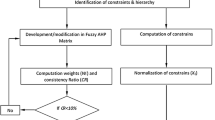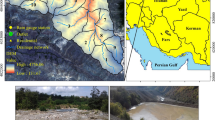Abstract
The article presents an efficient multi-criteria decision support model (MCDSM) to prioritize susceptible areas in a watershed for soil conservation measures based on impact analysis of topography, climate, morphology, soil, land cover, management and conservation factors. The MCDS model has been developed based on fuzzy analytical hierarchical process (FAHP) by computing its weights of nine erosion hazard parameters (EHPs), which include; soil loss from revise universal soil loss equation model, sediment yield, sediment production rate, sediment transport index, slope, drainage density, channel frequency, form factor, and circulatory ratio. The MCDS model has successfully been applied to Benisagar reservoir catchment in Madhya Pradesh (India), comprised of 36 sub-watersheds for prioritizing areas require soil conservation measures. For computing weights of EHPs in FAHPs, triangular, narrow rectangular, medium rectangular and wide rectangular fuzzy membership functions have been used followed by the geometric mean method to determine the final weight matrix. The test of consistency ratio showed wide rectangular function as the most effective one in determining the weights of EHPs with soil loss as the most sensitive and circulatory ratio as the least sensitive parameter. The final priorities of the sub-watersheds have been determined using weight and their corresponding normalized values of EHPs. Based on the clustering of final priorities, the sub-watersheds have been categorized into four groups of priorities, i.e., very high, high, medium, low and very low for soil and water conservation measures. The derived methodology can successfully be used in prioritization of soil conservation measures in a basin for developing catchment area treatment plan.





Similar content being viewed by others
References
Aggarwal R, Singh S (2013) AHP and extent fuzzy AHP approach for prioritization of performance measurement attributes. Int J Soc Manag Econ Bus Eng 7(1):43–48
Azizi A, Fathi K (2014) Selection of optimum maintenance strategies based on a fuzzy analytic hierarchy process. Manag Sci Lett 4(5):893–898
Bellman RE, Zadeh LA (1960) Decision making in fuzzy environment. Manag Sci 17B:141–164
Beynon M, Cosker D, Marshall D (2001) An expert system for multi-criteria decision making using Dempster Shafer theory. Expert Syst Appl 20(4):357–367
Buckley JJ (1985) Fuzzy herarchical analysis. Fuzzy Sets Syst 34:187–195
Chen SJ, Chen SM (2005) A prioritized information fusion method for handling fuzzy decision-making problems. Appl Intell 22(3):219–232
Chen SM, Lee LW (2010) Fuzzy multiple attributes group decision-making based on the interval type-2 TOPSIS method. Expert Syst Appl 37(4):2790–2798
Chen SM, Wang CH (2009) A generalized model for prioritized multicriteria decision making systems. Expert Sys Appl 36(3):4773–4783
Chen L, Quin X, Shi Y (2011) Critical area identification of potential soil loss in a typical watershed of Three Gorges reservoir region. Water Resour Manag 25(11):3445–3463
Chopra R, Dhiman DR, Sharma PK (2005) Morphometric analysis of sub-watersheds in Gurdaspur district, Punjab using remote sensing and GIS techniques. J Indian Soc Remote Sens 33(4):532–539
Chowdary VM, Chakraborthy D, Jeyaram A, Krishna Murthy YVN, Sharma JR, Dadhwal VK (2013) Multi-criteria decision making approach for watershed prioritization using hierarchy process technique and GIS. Water Resour Manag 27(10):3555–3571. doi:10.1007/s11269-013-0364-6
De Steiguer JE, Duberstein J, Lopes V (2003) The analytic hierarchy process as a means for integrated watershed management. In: Renard KG (ed) First Interagency Conference on Research on the Watersheds. Benson Arizona Oct 27–30 2003: 736–740
Deng H (1999) Multicriteria analysis with fuzzy pairwise comparisons. Int J Approx Reason 21:215–231
Fu G (2008) A fuzzy optimization method for multicriteria decision making: An application to reservoir flood control operation. Expert Syst Appl 34(1):145–149
Han WJ, Tsay WD (1998) Formulation of Quality Strategy Using Analytic Hierarchy Process. University of Northern Colorado, USA, pp 580–583, Twenty Seven Annual Meeting of the Western Decision Science Institute
Hill S, Zammet C (2000) Identification of community values for regional land use planning and management. Int Soc Eco Econ Cong Canberra Aust. July 5–8 2000
Hlaing TK, Haruyama S, Maung AM (2008) Using GIS-based distributed soil loss modeling and morphometric analysis to prioritize watershed for soil conservation in Bago river basin of Lower Myanmar. Earth Sci Chin 2(4):465–478
Horton RE (1932) Drainage basin characteristics. Trans Am Geophysics Un: 350–361
Horton RE (1945) Erosional development of streams and their drainage basins: hydrological approach to quantative morphology. Bull Geol Soc Am 56:275–370
Hsieh TY, Lu ST, Tzeng GH (2004) Fuzzy MCDM approach for planning and design tenders selection in public office buildings. Int J Proj Manag 22(7):573–584
Hua Z, Gong B, Xu X (2008) A DS–AHP approach for multi-attribute decision making problem with incomplete information. Expert Syst Appl 34(3):2221–2227
Jaiswal RK, Dehariya DK, Nema AK, Thomas T, Galkate RV (2012) Soil erosion based prioritization and development of CAT plan for catchment of Rangawan reservoir in Bundelkhand region of Madhya Pradesh (India). Nat Symp on Water Resour Manage in Changing Environ (WARMICE 2012) Roorkee (India) Feb 8–9 2012: 409–420
Jaiswal RK, Thomas T, Galkate RV, Singh S (2013) Rainfall analysis & assessment of irrigation water in a command of drought affected Bundelkhand Region (M.P.) India. Nat Conf on Sustainable Water Resour Develop and Manage (SWARDAM 2013) Aurangabad (India) Sept 30-Oct 01 2013: 20–27
Jaiswal RK, Thomas T, Galkate RV, Ghosh NC, Singh S (2014) Watershed prioritization using Saaty’s AHP Based decision support for soil conservation Measures. Water Resour Manag. doi:10.1007/s11269-013-0494-x
Jaganathan S, Jinson JE, Ker J (2007) Fuzzy analytic hierarchy process based group decision support system to select and evaluate new manufacturing technologies. Int J Adv Manuf Technol 32:1253–1262
Javanbarg MB, Scawthorn C, Junji K, Shahbodghkhan B (2012) Fuzzy AHP-based multicriteria decision making systems using particle swarm optimization. Expert Syst Appl 39:960–966
Josh CS, Dash DC (1982) Geomorphic prediction models for sediment production rate and intensive priorities of watersheds in Mayurakshi catchment. Int Symp Hydrol Aspects of Mountainous Watersheds Roorkee India Nov 4–6 1982: 15–23
Kafaky BS, Mataji A, Naser SA (2009) Ecological capability assessment for multiple-use in forest areas using GIS- based multiple criteria decision making approach. Am J Environ Sci 5(6):714–721
Kahraman C, Cebi S (2009) A new multi-attribute decision making method: Hierarchical fuzzy axiomatic design. Expert Syst Appl 36(3):4848–4861
Kong F, Lue H (2005) Applying fuzzy analytical hierarchy process to evaluate success factors of e-commerce. Int J Inf SystSci 1(3–4):406–412
Kordi M (2008) Comparison of fuzzy and crisp analytic hierarchy process (AHP) methods for spatial multicriteria decision analysis in GIS, Master Thesis, Deptt. of Technology and Built Enviroment, Univesity of Galve: 1–45
Kulak O (2005) A decision support system for fuzzy multi-attribute selection of material handling equipments. Expert Syst Appl 29(2):310–319
Kumar S, Mishra A (2015) Critical erosion area identification based on hudrological response unit level for effective sediment control in a river basin. Water Resour Manag 29(6):1749–1765
Lee AHI, Chen WC, Chang CJ (2008) A fuzzy AHP and BSC approach for evaluating performance of IT department in the manufacturing industry in Taiwan. Expert Syst Appl 34:96–107
Lin HY, Hsu PY, Sheen GJ (2007) A fuzzy-based decision-making procedure for data warehouse system selection. Expert Syst Appl 32(3):939–953
Malczewski J (1999) GIS and Multicriteria Desision Analysis. John Willey and Sons Inc, New York
Mallerowicz KT, Rees HW, Chow TL, Ghanem I (1994) Soil conservation planning at the watershed level using USLE with GIS and midro-computer technologies- a case study. J Soil Water Conserv 2:91–95
Mikhailov L (2003) Deriving priorities from fuzzy pairwise comparison judgments. Fuzzy Sets Syst 134:365–385
Mikhailov L, Tsvetinov P (2004) Evaluation of services using a fuzzy analytic hierarchy process. Appl Soft Comput 5:23–33
Miller VC (1953) Automated detection of drainage network from digital elevation models. Proc Sixth Int Symp Automated Cartography Ottawal USA: 288–291
Mishra SS, Nagarajan R (2010) Morphometric analysis and prioritization of subwatersheds using GIS and remote sensing techniques: a case study of Odisha, India. Int J Geomat Geosci 1(3):501–510
Mishra N, Satyanarayan T, Mukherjee RK (1984) Effect of topo elements on the sediment production rate from sub-watersheds in upper Damodar valley. J Agric Eng (ISAE) 21(3):65–70
Moore ID, Burch GJ (1986) Sediment transport capacity of sheet and rill flow: application of unit stream power theory. Water Resour Res. doi:10.1029/WR022i008p01350
Narumon I, Songkot D (2010) Analytical hierarchy process doe landslide susceptibility mapping in lower Mae Chaem watershed, Northern Thailand. Suranaree J Sci Technol 17(3):1–16
Oyatoye EO, Okpokpo GU, Adekoya GA (2010) An application of analytic hierarchy process (AHP) to investment portfolio selection in the banking sectors of the Nigerian capital market. J Econ Int Finance 2(12):321–335
Panda SS, Andrianasolo H, Steele DD (2005) Application of geotechnology to watershed soil conservation planning at the field scale. J Environ Hydrol 13(16):1–22
Rai SP, Sharma N, Lohani AK (2014) Risk assessment for transboundary rivers using fuzzy synthetic evaluation technique. J Hydrol 519(B 27):1551–1559
Rao HSS and Mahabaleswara H (1990) Prediction of rate of sedimentation of Tungabhadra reservoir, Proc Symp Erosion, Sedimentation Resour Conserv Dehradun India: 12–20
Renard KG, Foster GR, GAW, Porter JP (1991) RUSLE, revised soil loss equation. J Soil Water Conserv 46(1):30–33
Saaty TL (1980) Fundamentals of decision making and priority theory with analytical hierarchical process Vol VI. RWS Publications University of Pittsburgh, Pittusburgh, pp 3–95
Sharma SK, Rajput GS, Tignath S, Pandey RP (2010) Morphometric analysis and prioritization of a watershed using GIS. J Indian Water Res Soc 30(2):33–39
Singh G, Chandra S, Babu R (1981) Soil loss and prediction research in India. Central Soil and Water Conserv Resear Training Inst India, Bulletin No. T-12/D9
Srdejevic Z, Bajcetic R, Srdjevic B (2012) Identifying the criteria set for multi criteria decision making based on SWOT/PESTLE analysis: A case study of reconstructing a water intake structure. Water Resour Mamag 26(12):3379–3393
Srdjevic B, Mediros YDP (2008) Fuzzy AHP assessment of water management plans. Water Resour Manag 22:877–894. doi:10.1007/s11269-012-0077-2
Shrimali SS, Aggarwal SP, Samra JS (2001) Prioritizing erosion-prone areas in hills using remote sensing and GIS - a case study of the Sukhna lake catchment, northern India. Int J Appl Earth Observ Geoinf 3(1):54–60
Tacker EC, Silvia MT (1991) Decision making in complex environments under conditions of high cognitive loading: A personal expert systems approach. Expert Syst Appl 2(2–3):121–127
Tam CM, Tong TKL, Leung AWT, Chiu GWC (2002) Site layout planning using nonstructural fuzzy decision support system. J Construction Engg Manage DOI: 10.1061(ASCE)0733-9364(2002)128:3(220)
Torfi F, Farahani RZ, Rezapour S (2010) Fuzzy AHP to determine the relative weights of evaluation criteria and Fuzzy TOPSIS to rank the alternatives. Appl Soft Comput 10(2):520–528
Vittala SS, Govindaiah S, Gowda HH (2004) Morphometric analysis of sub-watersheds in the Pavagada area of Tumkar district, south India using remote sensing and GIS techniques. J Indian Soc Remote Sens 32(4):351–362
Wang G, Gertner G, Parysow P, Anderson AB (2000) Spatial prediction and uncertainty analysis of topographic factors for the revised soil loss equation (RUSLE). J Soil Water Conserv 374–384
Wang L, Chu J, Wu J (2007) Selection of optimum maintenance strategies based on a fuzzy analytic hierarchy process. Int J Prod Econ 107:151–163
Wang YM, Luo Y, Hua Z (2008) On the extent analysis method for fuzzy AHP and its applications. Eur J Oper Res 186(2):735–747
Wischmeier WH, Smith DP (1978) Predicting rainfall erosion losses-a guide to conservation planning. US Department of Agriculture, Washington, pp 58–61, Agriculture hand-book No 537
Yahaya S, Ahamd N, Abdalla RF (2010) Multicriteria analysis for flood vulnerable areas in Hadejia-Jama’are river basin, Nigeria. Euro J Sci Res 42(1):72–83
Yager RR (1991) Non-monotonic set theoretic operations. Fuzzy Sets Syst 42(2):173–190
Yager RR (1992) Second order structures in multi-criteria decision making. Int J Man–Mach Stud 36(6):553–570
Zadeh L (1965) Fuzzy sets. Inf Control 8(3):338–353
Zimmermann HJ (1934) Fuzzy Set Theory—and Its Applications, 3rd edn. Kluwer Academic Publishers, Boston/Dordrecht/London
Author information
Authors and Affiliations
Corresponding author
Rights and permissions
About this article
Cite this article
Jaiswal, R.K., Ghosh, N.C., Lohani, A.K. et al. Fuzzy AHP Based Multi Crteria Decision Support for Watershed Prioritization. Water Resour Manage 29, 4205–4227 (2015). https://doi.org/10.1007/s11269-015-1054-3
Received:
Accepted:
Published:
Issue Date:
DOI: https://doi.org/10.1007/s11269-015-1054-3




